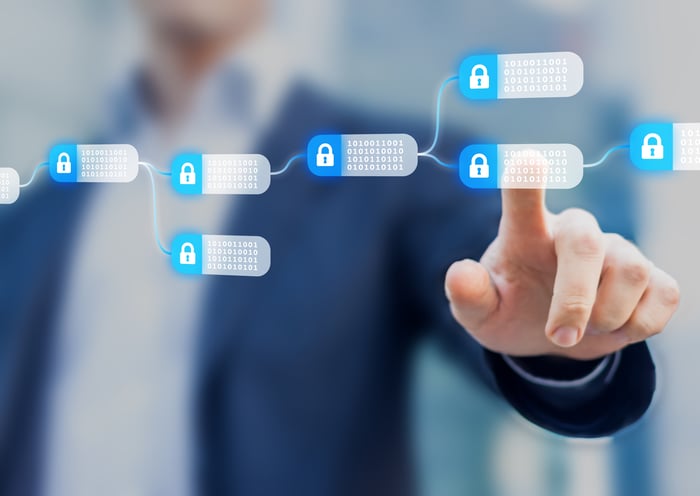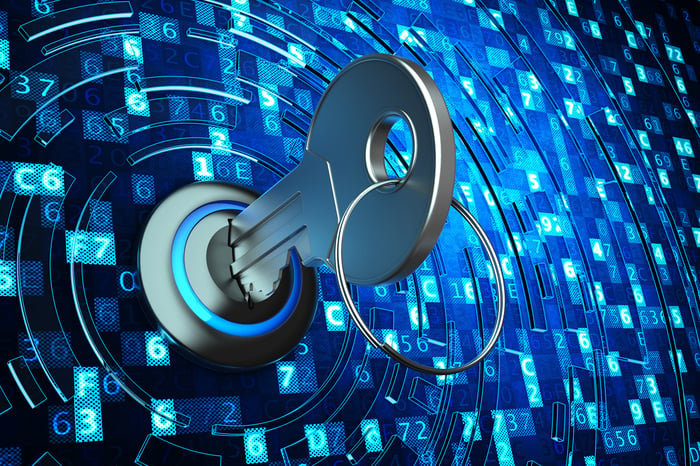In one corner, we have Apple (AAPL -1.92%), the largest publicly traded company in the U.S. based on market cap and a business that likely needs no introduction. In its most recently reported quarterly operating results, it generated $88.3 billion in sales, sold 77.3 million iPhones at an average selling price of $796, tallied 240 million paid subscriptions via its App Store, and ended the quarter with "just" $285 billion in cash, $269 billion of which is held in overseas markets. It's rightly a tech mammoth.
In the other corner, we have blockchain technology, which is being touted as the greatest thing since sliced bread for industries ranging from financial services to retail and technology. Blockchain describes the digital, distributed, and decentralized ledger that's responsible for transparently and immutably (i.e., in an unchanging manner) recording all transactions without the need for a financial intermediary, which is often a bank.

Image source: Getty Images.
Initially, when bitcoin debuted in 2009, the buzz about blockchain primarily revolved around its uses for the financial services industry. It was believed to be a means to improve the peer-to-peer payment process by reducing transaction fees as a result of cutting out the middleman (banks), and dramatically speeding up the validation and settlement process of payments relative to the current banking system. But there's much more to blockchain than this.
Blockchain is also being examined as a means to more effectively control supply chains, as well as quickly locate inefficiencies within logistics operations. Additionally, it can be used to immutably log medical records, create digital IDs, and act as a loyalty-rewards platform for retailers, to name a few of its noncurrency projects.
Now, the world's most valuable company and the buzziest concept in the business universe may be joining forces.
Apple and blockchain? Yeah, that might be a thing
Back on Dec. 7, 2017, it became public information that Apple had filed a patent application (officially, "Obtaining and Using Time Information on a Secure Element") with the U.S. Patent and Trademark Office for a timestamp verification system that would potentially incorporate the use of blockchain. Keep in mind that patent applications are usually made public 18 months after they've been filed, meaning that Apple has probably been tinkering with the idea of a blockchain-based timestamp verification system for a good two years, if not longer.

Image source: Getty Images.
According to the filing, Apple would use multicheck architecture that incorporates Public Key Infrastructure and blockchain to verify the authenticity of timestamps and protect secure elements (SE), such as SIM cards or microSD cards that could contain critical information. In the third scenario described in the filing:
Because of distributed consensus, attempted alteration of the blockchain by a malicious node in terms of the time value will be detected by honest nodes. In the third scenario, a maliciously altered block in the blockchain will not be recognized by the device and will not be recognized by the SE and thus a bogus time value will not corrupt the state of the SE.
In plainer English, because blockchain transactions are transparent and unchanging, dishonest actions taken by a malicious individual or group of individuals to alter a timestamp would allow all persons on that network to see this occurring. It would also create unauthorized blocks that wouldn't be properly recognized, thus invalidating those blocks and reauthenticating the proper timestamp.
Why timestamps?
Though there could be a host of reasons not mentioned in the patent application filing for focusing on timestamps, it specifically points out how global positioning systems (GPS) and network serves reliant on NTP (network time protocol) could be impacted by a malicious user aiming to disrupt a timestamp before it reaches the secure element.

Image source: Getty Images.
For example, NTP network time servers likely aid in the control of these basic functions around today's modern businesses:
- Network accelerators: These accelerators rely on accurate timestamps to determine the most current piece of data.
- Data backups: Without proper timestamping, backing up data could become impossible.
- Network intrusion: NTP servers aid with pinpointing malicious attack times, so businesses can determine what, if any data, was compromised.
- Network management systems: Timestamps provide an easy means for network administrators to locate and fix problems.
- Trading systems: It probably goes without saying that electronic trading systems are dependent on clocks.
In short, the ability for a hacker to alter timestamp data could have drastic consequences on businesses of varied sizes.
Additionally, even though it's merely glanced over in the patent filing, this multi-check architecture that incorporates blockchain may also prove worthwhile for expiring public-key certificates. Blockchain data, being immutable, would render these expirations a moot point and create so-called "timeless guarantees."
It's also possible an even broader application of this technology would be to protect vendors from malicious attacks that would alter the expiration date of licensed software, but that's mere conjecture on my part.
Apple isn't alone
Of course, Apple is far from the only tech giant to "tinker" with the idea of using blockchain technology. Both Microsoft (MSFT 0.23%) and IBM (IBM 1.38%) have been prime advocates of its testing.

Image source: Getty Images.
Last month, Microsoft announced via a blog post that it would be tackling the identity challenge that more than 1 billion people face worldwide by developing blockchain-based IDs. Believing that blockchain represents the best way to protect digital IDs and allow individuals control over their own digital identities, Microsoft is developing a decentralized system that could more efficiently verify personal credentials. In particular, this blockchain project would allow developers to customize apps and services that rely on attestations -- i.e., claims about a person's identity that other entities endorse -- which would require less of a user's personal info to be processed.
Meanwhile, IBM has its hands in a little bit of everything when it comes to blockchain. In October, it partnered with Stellar to use the latter's digital tokens, known as Lumens, on its blockchain in the South Pacific. A dozen major banks in the region are testing cross-border payments over IBM's blockchain with Lumens being used as the intermediary currency.
Even more recently, IBM and shipping giant A.P. Moller-Maersk announced their intention to form a separate company via a joint venture to develop blockchain-based solutions for the shipping industry. The duo believes that the start-up-like environment of being a separate entity will bode well for innovative purposes.
In short, big tech companies are really beginning to embrace the possibilities of blockchain technology. The big question is: Will 2018 finally be the year we move beyond proof of concept and into real-world testing? With the biggest name in tech now involved, we could be closing in on an answer.





